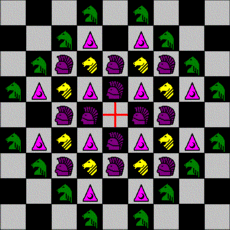ximeracak.
Fantasy chess with an ordinary set
By Glenn Overby
Introduction
ximeracak., or in English Chimerical Chess, is a fantasy chess variant. It can be played with an orthodox chess set, using:
- king for General;
- queen for Pegasus;
- bishops for the colorbound Wizards;
- knights for Knights;
- rooks for the leftover Champions;
- and pawns for Sergeants.
The game started as an attempt to incorporate the Champion and Wizard of the commercial variant Omega Chess into an 8x8 game. Adding the Pegasus from the designer's earlier Beastmaster Chess, and retaining the Knight, led to a marked fantasy feel and the curious characteristic that it is impossible to block one's opponent. Thus, the Chimerical name. Sometimes chaotic fits as well.
Setup

Gold: General f1; two Champions a1, h1; two Knights b1, g1; Pegasus c1; two Wizards d1, e1; eight Sergeants a2, b2, c2, d2, e2, f2, g2, h2.
Green: General c8; two Champions a8, h8; two Knights b8, g8; Pegasus f8; two Wizards d8, e8; eight Sergeants a7, b7, c7, d7, e7, f7, g7, h7.
Most piece graphics originally by David Howe. The diagram is a screenshot from the Zillions of Games implementation.
Pieces
Champion
A Champion combines three moves. It can move one space or two spaces horizontally or vertically, or exactly two spaces diagonally. The two space moves ignore intervening pieces. This combines the alfil, dabbabah, and wazir of several historic games.
The Champion was invented by Daniel Macdonald for his Omega Chess variant in the 1990s.
Knight
A Knight moves like a big L, two squares vertically plus one horizontally, or two squares horizontally plus one vertically. It hops over any pieces on the way.
The Knight is the only orthodox chess piece used in this game. Its origins are found in the earliest known chess games.
Pegasus
A Pegasus moves a total of five squares in a big L-shape, in a 3+2 or 4+1 pattern. Like the Knight who it imitates, the Pegasus ignores all intervening pieces. (Some variants recognize the (1,4) leaper as a giraffe, and the (2,3) leaper as a zebra.)
I created the Pegasus for my large variant Beastmaster Chess, together with two other hybrid leapers, the roc and the wyvern. In Greek mythology, Pegasus was a flying horse.
Wizard
A Wizard combines two moves. It may move one space diagonally, like the old Islamic ferz, or in a 3+1 exaggerated 'L' much like a Knight, also leaping occupied squares. (The latter move is sometimes known as a camel's move.)
The Wizard was invented by Daniel Macdonald for his Omega Chess variant in the 1990s.

The diagram above (which is extended to 9X9 for illustration) shows the moves of each of the four major pieces from the central square marked with a cross. Note that two different types of major piece can never threaten each other at once. A Knight menacing a Wizard is in no danger from it, or a Champion from the Pegasus it attacks, or any other combination.
General
A General moves one space horizontally, vertically, or forward diagonally, like the gold general of Shogi. It may not move into check, just like a standard king. If your General is checkmated, stalemated, or alone, you lose.Sergeant
A Sergeant can move or capture one square forward or diagonally forward. On its first move, the Sergeant also has a double-step option directly forward only, without capturing or hopping, just like an ordinary pawn. (The Sergeant combines the moves of an ordinary and Berolina pawn.) There is no en passant capture.
When a Sergeant reaches the opponent's back rank, all the way across the board, it may promote to Champion, Knight, Pegasus, or Wizard. However, a Sergeant's promotion is limited to pieces previously captured by the opponent and still available. A player may not have three Champions or two Pegasi, for example.
The Sergeant goes back to at least the 1940s, and possibly earlier.
Rules
The following differences from orthodox chess are in addition to the board and pieces.
- Gold moves first.
- Stalemate is a loss.
- A player who loses their last piece other than the General has lost.
- Promotions are limited to the pieces of the original force mix. (It bears repeating.)
Notes
At first, this game is tricky to visualize, because ordinary concepts of lines, structures, and blocking have ceased to exist. Long jumps like the Wizard and Pegasus are particularly odd for new players, and a couple of fool's mates exist.
Endgames tend to be more dynamic, because blocking is almost impossible. It's not unusual for both sides to promote, even more than once.
The name of the game, by the way, is properly spelled with both the lower-case x and the period. ximeracak. is a Lojban name, derived from an Esperanto form which uses thingys that aren't in the Latin-1 orthography.
Computer Play
If you have Zillions of Games installed on your computer, you can play this game. Download file: ximeracak.zip.
Written by Glenn E. Overby.
WWW page created: August 10, 2002.